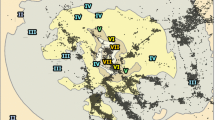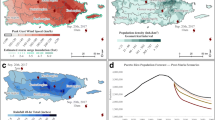Abstract
In this work, we analyse mobile phone variation before and after the 2016 Central Italy earthquake in the affected areas, using Twitter and public reconstruction works data. We create three models and show that Twitter data and the related sentiment on the earthquake, as well as the distribution of emergency houses, can contribute to explaining population variations. Our final Generalised Poisson regression model explains more than 80% of the variance of the population’s variation based on the percentage of negative polarity tweets, the number of emergency houses, the number of negative tweets on the earthquake weighted by the number of residents, number of tweets posted on the earthquake anniversary, the distance from the epicentre and several variables related to public reconstruction works (e.g. school, public housing, hydrological disruption, viability). We found that sentiment on the emergency house can be a proxy for population variation because people who live there did not displace from the crater area. The number of tweets posted during the anniversary day can, instead, indicate negative population variation because the higher the number of tweets, the more people can feel nostalgic after having relocated.






Similar content being viewed by others
Data and code availability
Data and codes that support this study are available in Figshare with private link: https://figshare.com/s/5bec763c3c5c20669b71.
References
Beigi G, Hu X, Maciejewski R, Liu H (2016) Sentiment analysis and ontology engineering: an environment of computational intelligence. In: Pedrycz W, Chen S-M (eds) Springer, pp 313–340
Bengtsson L, Lu X, Thorson A, Garfield R, von Schreeb J (2011) Improved response to disasters and outbreaks by tracking population movements with mobile phone network data: a post-earthquake geospatial study in Haiti. PLoS Med 8(8):1–9
Blumenstock J (2012) Inferring patterns of internal migration from mobile phone call records: evidence from Rwanda. Inf Technol Dev 18(2):107–125
Cesario E, Comito C, Talia D (2017) An approach for the discovery and validation of urban mobility patterns. Pervasive Mob Comput 42:77–92
Comito C, Talia D (2004) GDIS: a service-based architecture for data integration on grids. In: On the move to meaningful internet systems 2004: OTM 2004 workshops: OTM confederated international workshops and posters, GADA, JTRES, MIOS, WORM, WOSE, PHDS, and INTEROP 2004, Agia Napa, Cyprus, October 25–29, 2004 Proceedings, pp. 88–98
Contreras D, Wilkinson S, Balan N, James P (2022) Assessing postdisaster recovery using sentiment analysis: the case of L’aquila, Italy. Earthq Spectra 38(1):81–108
Doan S, Vo B, Collier N (2012) An analysis of twitter messages in the 2011 Tohoku earthquake. In: Kostkova P, Szomszor M, Fowler D (eds) Electron Healthc. Springer, Berlin, pp 58–66
Ford J, Tilleard S, Berrang-Ford L, Araos M, Biesbroek R, Lesnikowski A, Bizikova L (2016) Opinion: big data has big potential for applications to climate change adaptation. Proc Natl Acad Sci 113(39):10729–10732. https://doi.org/10.1073/pnas.1614023113
Kejriwal M, Zhou P (2020) On detecting urgency in short crisis messages using minimal supervision and transfer learning. Soc Netw Anal Min 10(1):58
King D (2000) You’re on your own: community vulnerability and the need for awareness and education for predicatable natural disasters. J Conting Crisis Manag 8(4):223–228
Kontokosta C, Malik A (2018) The resilience to emergencies and disasters index: applying big data to benchmark and validate neighborhood resilience capacity. Sustain Cities Soc 36:272–285
Latonero M, Shklovski I (2010) ‘Respectfully yours in safety and service’-emergency management & social media evangelism. SSRN 1566423
Li S, Liu Z, Li Y (2020) Temporal and spatial evolution of online public sentiment on emergencies. Inf Process Manag 57(2):102177
Lu X, Bengtsson L, Holme P (2012) Predictability of population displacement after the 2010 Haiti earthquake. Proc Natl Acad Sci 109(29):11576–11581
Nagy A, Stamberger J (2012) Crowd sentiment detection during disasters and crises. In: Rothkrantz L, Ristvej J, Franco Z (eds) 9th proceedings of the international conference on information systems for crisis response and management, Vancouver, Canada, April 22-25, 2012. Simon Fraser University, Vancouver, pp 1–9
Polignano M, Basile P, de Gemmis M, Semeraro G, Basile V (2019) AlBERTo: Italian BERT language understanding model for NLP challenging tasks based on tweets. In: Proceedings of the sixth Italian conference on computational linguistics (CLiC-IT 2019), vol 2481. CEUR
Rudra K, Ganguly N, Goyal P, Ghosh S (2018) Extracting and summarizing situational information from the twitter social media during disasters. ACM Trans Web TWEB 12(3):1–35
Şen F, Wigand R, Agarwal N, Tokdemir S, Kasprzyk R (2016) Focal structures analysis: identifying influential sets of individuals in a social network. Soc Netw Anal Min 6:1–22
Simon T, Goldberg A, Adini B (2015) Socializing in emergencies-a review of the use of social media in emergency situations. Int J Inf Manag 35(5):609–619
Wang Y, Taylor J (2018) Coupling sentiment and human mobility in natural disasters: a Twitter-based study of the 2014 South Napa Earthquake. Nat Hazards J Int Soc Prev Mitig Nat Hazards 92(2):907–925
Wesolowski A, Stresman G, Eagle N, Stevenson J, Owaga C, Marube E, Buckee CO (2014) Quantifying travel behavior for infectious disease research: a comparison of data from surveys and mobile phones. Sci Rep 4(1):5678
Wilson R, zu Erbach-Schoenberg E, Albert M, Power D, Tudge S, Gonzalez M et al (2016) Rapid and near real-time assessments of population displacement using mobile phone data following disasters: the 2015 Nepal earthquake. PLoS Curr 8
Wu L, Chikaraishi M, Nguyen H, Fujiwara A (2021) Analysis of post-disaster population movement by using mobile spatial statistics. Int J Disaster Risk Reduct 54:102047
Yabe T, Tsubouchi K, Fujiwara N, Sekimoto Y, Ukkusuri S (2020) Understanding post-disaster population recovery patterns. J R Soc Interface 17(163):20190532
Yabe T, Ukkusuri S, Rao P (2020) Mobile phone data reveals the importance of pre-disaster inter-city social ties for recovery after Hurricane Maria. Appl Netw Sci 5(1):1–18
Author information
Authors and Affiliations
Contributions
NSH, MM and ML wrote the main manuscript text and made the analysis, NSH wrote the code and prepared figures 1-6. All authors reviewed the manuscript.
Corresponding author
Ethics declarations
Conflict of interest
The authors declare no conflict of interest.
Rights and permissions
Springer Nature or its licensor (e.g. a society or other partner) holds exclusive rights to this article under a publishing agreement with the author(s) or other rightsholder(s); author self-archiving of the accepted manuscript version of this article is solely governed by the terms of such publishing agreement and applicable law.
About this article
Cite this article
Hadjidimitriou, N.S., Lippi, M. & Mamei, M. Explaining population variation after the 2016 Central Italy earthquake using Call Data Records and Twitter. Soc. Netw. Anal. Min. 13, 140 (2023). https://doi.org/10.1007/s13278-023-01139-z
Received:
Revised:
Accepted:
Published:
DOI: https://doi.org/10.1007/s13278-023-01139-z




